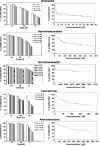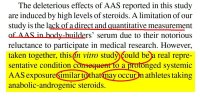You can't make such conclusive statements with in vitro and rat studies, and correlational studies.
Even the researchers don't go so far:
For example, correlation does not equal causation in brain changes studies. It's just speculation:
View attachment 144511And the nandrolone is 11x worse than testosterone... it's a big leap to go from in vitro to human conclusions. Notice the qualifiers from researchers:
View attachment 144513
The conclusions are overstated, often mere speculation, and have not been proven in humans for most of these studies. We need to be careful speaking beyond what the evidence actually says.
Source:
Bjørnebekk, A., Walhovd, K. B., Jørstad, M. L., Due-Tønnessen, P., Hullstein, I. R., & Fjell, A. M. (2017). Structural Brain Imaging of Long-Term Anabolic-Androgenic Steroid Users and Nonusing Weightlifters.
Biological Psychiatry,
82(4), 294–302.
Redirecting
D’Ascenzo, S., Millimaggi, D., Di Massimo, C., Saccani-Jotti, G., Botrè, F., Carta, G., Tozzi-Ciancarelli, M. G., Pavan, A., & Dolo, V. (2007). Detrimental effects of anabolic steroids on human endothelial cells.
Toxicology Letters,
169(2), 129–136.
Redirecting




